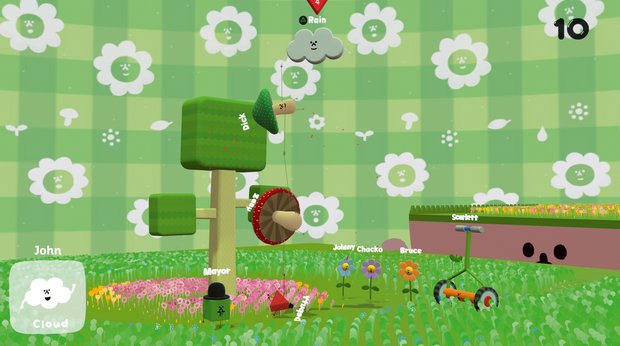What's Wattam?
We’re as surprised as you to hear that Katamari Damacy and Noby Noby Boy creator Keita Takahashi has decided to curb the eccentricity of his latest game a little. “I understand that Noby Noby Boy was too much for some people,” he says with a grin, “so I just tried to find the middle ground. And that’s Wattam.”

Don’t worry, Wattam is still delightfully odd. It follows a little cuboid mayor and his efforts to repopulate a town in the aftermath of a surreal cataclysm. You’ll frolic and clamber about, experimenting with each new resident’s abilities to create ever-larger people explosions (not a metaphor: characters soar into the air and go bang), which bring joy to potential residents and Funomena’s curious sandbox to life. It sounds, and looks, bizarre, but it’s an instantly arresting and entirely charming proposition once you get your hands on the controller. And Takahashi’s right: it really does feel like a happy mix of the best elements of his best-known games.
“You have that really structured time-based gameplay with Katamari, which I think Keita felt was a bit too [constrained]; then there’s the open-ended playspace of Noby Noby Boy, which is kind of Keita’s dream, but for me felt a little unstructured,” Funomena CEO Robin Hunicke explains. “You can play Wattam in the way you would play Noby Noby Boy, or if you want to play it as you would play something more directed, you can. Then in the middle of those two styles is a game where you sometimes play the story, and then sometimes take a break and experiment with the characters… It’s a conscious decision.”
Ironically, that conscious decision has resulted in something that feels dreamlike, though surreal, disparate elements somehow fuse into a whole that makes sense within the context of play. For example, explosions are triggered by a bomb stored under the mayor’s bowler hat, but first you must stack a certain number of characters on top of each other, switching control between those you’d like in the detonation until the swaying tower reaches the requisite number of bodies. Hold down the bomb button at this point and the group will take off in a swirling formation, leaving trails behind them as the skies light up, which encourages yet more residents to move into your town. It’s a manifestation of unrestrained joy – the satisfying culmination of each delightful experiment that preceded it. It feels apt for a game with only a passing interest in traditional design principles.

“I think at the very beginning, we bit off more than we could chew,” Hunicke says. “We tried to write a physical solver that would allow us to have stretchy, bendy attachments between characters, so all the stacks could be really wobbly, because we wanted to get that sensation of Jenga-esque teeter-totting. Then as we iterated on it, and we realised we didn’t need all that power. We just needed to make the characters appealing and childlike. So instead of spending a significant period of time developing that physics system, we invested more time in AI behaviour and animation that allows us to put a lot of character into each person that’s in Wattam.”
They’re a memorable lot. Take the coffee bean: he can run really fast, but also wake up dozing characters who succumb to the Midas-like curse of a lonely pillow who puts to sleep those he touches. The cloud can float around and rain on grass to grow flowers, a bunch of which can be plucked and added to your character list. Then there’s the piece of sushi with the jetpack and the turntable who can start a party anywhere. Mucking about and seeing how each person’s abilities affect those around them is an amusing, open-ended distraction, and some add a puzzle element to creating stacks once you choose to press on with the game’s loose objectives.
There’s still plenty to firm up, but while Funomena is allowing the game the space it needs to evolve naturally, the ideas at the centre of it have remained core to Takahashi’s vision, inspired by watching his children play. “[It’s been] two years, and it’s not finished yet,” he says, “but my concept, my idea, hasn’t changed. It’s very clear, I guess. Maybe [it’s because] it’s so crazy…”
Sign up to the GamesRadar+ Newsletter
Weekly digests, tales from the communities you love, and more

“The lock screen on my phone right now is Keita and his son playing the game!” says Hunicke. “When he was two years old, they were stacking stuff and playing with wooden blocks, and Keita started doing stuff that was pretty crazy with them, and the kid was laughing and responding really positively. Now he’s four, and he can play this game! So when we finish, he’ll be five, and Keita can say, ‘Hey, I made this for you!’ I think that’s the best thing a parent can give to a child – something that’s really inspired by them.”
Read more from Edge here. Or take advantage of our subscription offers for print and digital editions.
Edge magazine was launched in 1993 with a mission to dig deep into the inner workings of the international videogame industry, quickly building a reputation for next-level analysis, features, interviews and reviews that holds fast nearly 30 years on.



